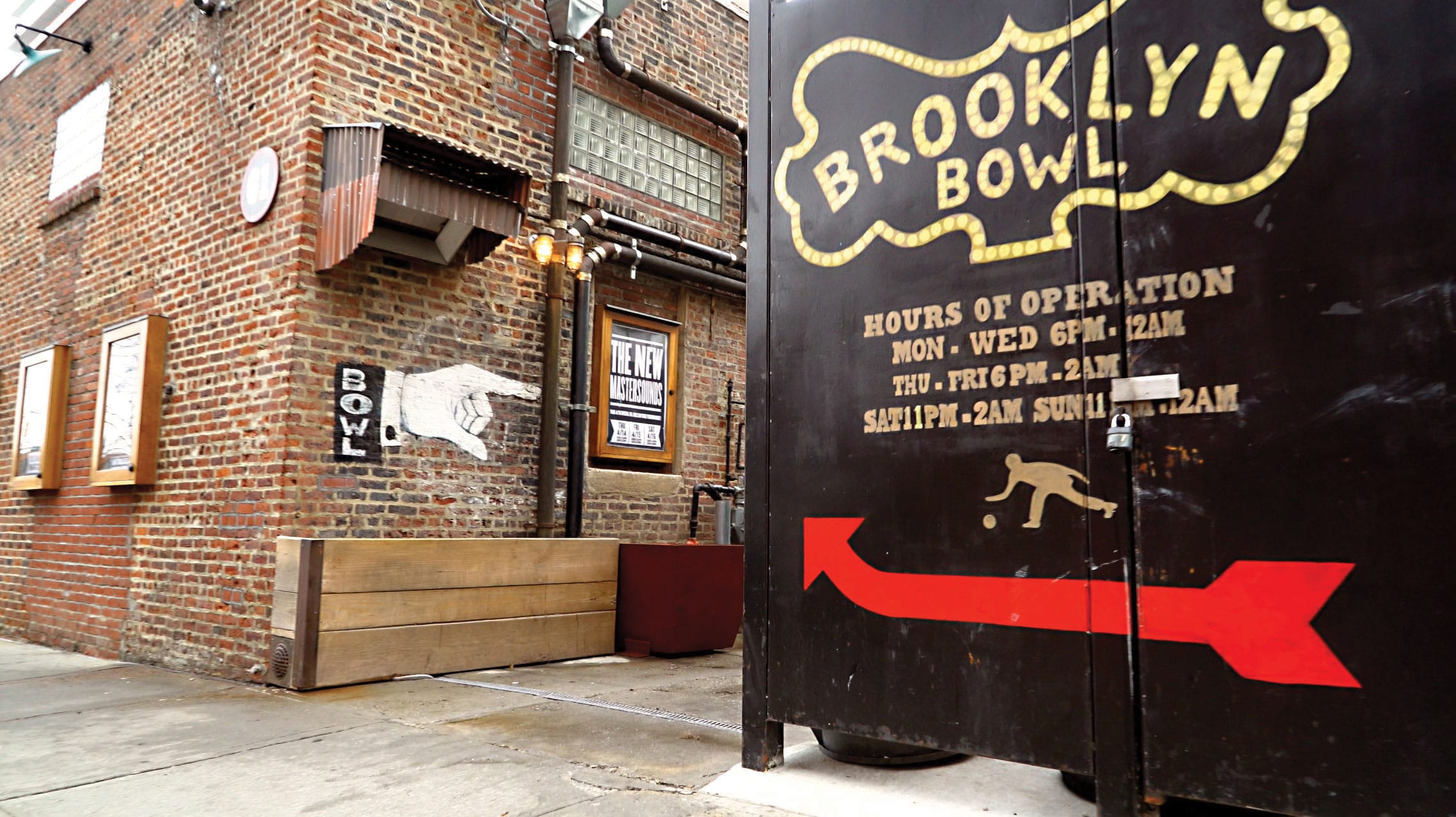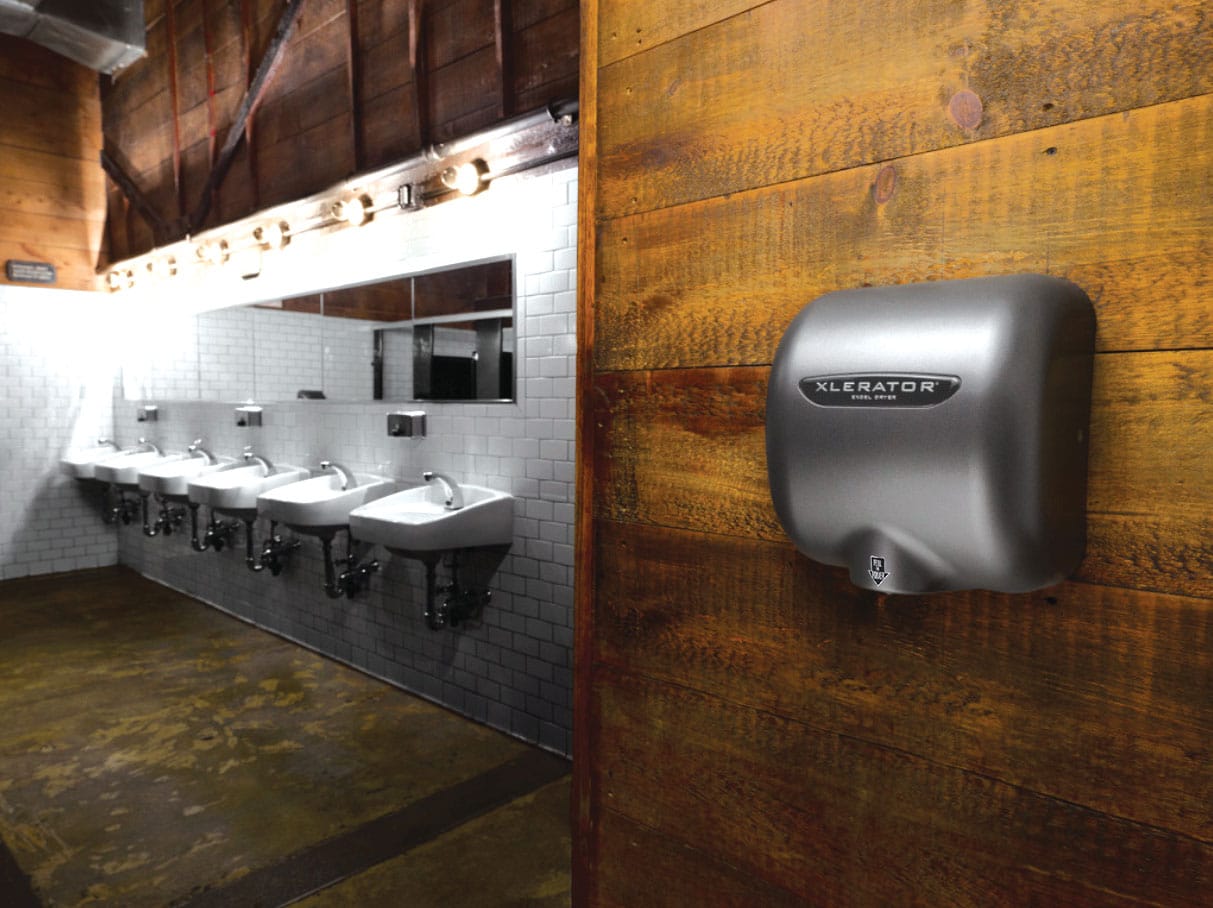
Excel Dryer’s XLERATOR® Hand Dryers use electricity to quickly dry (in as little as eight seconds) the hands of up to 3,000 people who patronize the Brooklyn Bowl on any given day. [Photo: Courtesy of Excel Dryer]
The ever-popular Brooklyn Bowl earned its LEED certification with a lot of reused materials. But hot air hand dryers blew recycled paper towels off the premises.
 Download a PDF of this story.
Download a PDF of this story.
To learn more, visit AgilQuest.
When Brooklyn Bowl was LEED certified in 2011, it was the first bowling alley anywhere to achieve this designation. Its funky aesthetic—modeled after Coney Island—is an example of extreme recycling. Reconstituted truck tires make up the stage floor, while fixtures, furniture, glass space dividers, and the building itself (a former iron foundry) are repurposed and revitalized to serve this very lively place.
But in the bathrooms you won’t find recycled paper towels for hand drying. Instead, Excel Dryer’s XLERATOR® Hand Dryers use electricity to quickly dry (in as little as eight seconds) the hands of up to 3,000 people who patronize the bowling-concert-restaurant establishment on any given day. Add to that the venue’s 200 employees who, as we know, must wash their hands, and that’s some big demand.
New Yorkers Want the Real Deal
The common misperception of “100% recycled paper towels” is that they are somehow in an endless use-recycle-use-recycle path. The reality is that while towel content is recycled, it all ends up being hauled into the waste stream after a single use. And that’s after materials are shipped to and from the recycling facility.
A lifecycle assessment in 2009 of the XLERATOR dryer (conducted by Quantis International) looked at materials production, manufacturing, transportation, use, and end-of-life factors to see how this high-velocity air hand dryer performs relative to recycled paper towels. On a per-use basis, the air dryers were found to use 76 kilojoules of energy, about one-tenth the energy required to provide a paper towel drying (743 kilojoules).
The assessment also accounted for sources of electricity, finding that a significant advantage remains present for these modern hand dryers even when the power comes from fossil fuel-burning plants. In the worst-case scenario—if electricity running the hand dryer is from coal-run plants while wind energy is used to produce 100% recycled paper towels—hand dryers make a 27% lower contribution to climate change than recycled paper towels.

Brooklyn Bowl was the first bowling alley to earn LEED certification. [Photo: Courtesy of Excel Dryer]
Operational Efficiency Equals Success
These are numbers that mattered to the developer-owners of Brooklyn Bowl, Peter Shapiro and Charley Ryan. Their sophisticated clientele can see past a LEED plaque on a wall to question not just how a facility is built but also how it operates.
To general manager Stephen Schwarz, it’s the operational performance that affects him every single day. “I actually used to hate air dryers,” he says. “They didn’t work.” But it’s the old dryers he’s referring to, which were much more common eight years ago when the XLERATORs were selected for the then-new facility. That impression changed when he saw how the new product performed, truly drying hands in a matter of seconds.
What continues to sell him on air dryers is that restroom traffic flow is faster while maintenance is immensely simplified. “There is a need for speed in a club,” says Schwarz. “We make sure we have enough bartenders on staff to serve our customers. The same goes for the bathrooms. No one wants to wait.” Nor do they want clogged toilets from incorrect towel disposal, an operational challenge that plagues the entertainment and hospitality industry.
The patrons at Brooklyn Bowl are indeed a study in motion. At its peak, bowlers take up all 16 lanes while restaurant patrons and concert fans fill its 3,000-person capacity hall. The facility is 100% wind-powered, with walls faced in Forest Stewardship Council–certified wood, a highly efficient HVAC system and waterproofed walls thanks to a soy-based, zero-VOC primer-sealer. The beer selection focuses on Brooklyn-made brews, the bowler’s lounge floor is made from recycled cork, and a bike rack outside accommodates at least 30 cyclists.
This is actually the second venue for Shapiro and Ryan, who created something called the Wetlands Preserve in 1989 in Manhattan. It hosted bands as well as meetings for environmental activists. The move to Brooklyn 20 years later extended that idea, this time in a sustainable building.

Brooklyn Bowl. [Photo: Courtesy of Excel Dryer]
BY THE NUMBERS
2,400 watts
What conventional (lower velocity) hand dryers operate on
500-1500 watts
What new (higher velocity) hand dryers like XLERATOR Hand Dryers operate on
30-45 seconds
Time required to dry with lower velocity hand dryers
8-14 seconds
Time required to dry with higher velocity hand dryers like Excel Dryer’s
60-80 decibels
Range of sound created by higher velocity hand dryers; 60 is slightly above the level of conversation and 80 approximates the sound of a vacuum cleaner. (Optional accessories include Excel Dryer’s noise reduction nozzle, which eliminates air deflection noise and reduces the sound level by 9 decibels.)
Hand Dryers as Design Statements
The idea to use the XLERATOR at Brooklyn Bowl came about somewhat organically. A talent booker for the venue stepped outside her usual role to tell Shapiro and Ryan that she had seen the air dryers in other clubs. Apparently, she was quite insistent on both the point and the model: the high-speed, energy-efficient XLERATOR from Excel Dryer.
It’s important to note that not all XLERATORs look the same. The manufacturer’s vice president of marketing and sales, William Gagnon, says the specific textured, gunmetal gray paint had been custom designed for Wembley Stadium in London (built in 2007). That style has proven to be so popular that it is no longer considered a “custom” cover, instead being added as a standard offering alongside traditional white, brushed stainless steel, chrome plated, metallic finishes like gold, copper, bronze, and more—making the Excel Dryer line of products the most customizable on the market. Some sports teams, like the New England Patriots at Boston’s Gillette Stadium, have taken advantage of Excel Dryer’s exclusive digital imaging technology, designing custom covers featuring their respective team logos. The technology allows the dryers to be branded with a fully integrated design, rather than a sticker or other surface brand that could easily be marred or removed. The result is a custom cover that matches both the buyer’s aesthetic and even the most eclectic restroom decor, as was the case with Brooklyn Bowl.
Brooklyn Bowl was a gut rehab, with entirely modern electrical systems capable of serving the demands of sound systems, video monitors, and lighting for the 80,000-square-foot facility. But Gagnon says a large portion of restaurants, schools, sports facilities, and entertainment venues are in older buildings where electrical systems might be decades old. Two dryers from the Excel Dryer line—the XLERATOR and the XLERATOReco—can also operate on the 15-amp circuits found in many older buildings. What’s more—with its “no heat” technology, XLERATOReco draws 4.5 amps or less, which allows for the installation of multiple XLERATOReco units on one circuit, significantly reducing installation costs and creating a return on investment of less than one year.
An environmentally conscious public increasingly embraces recycled materials. But Brooklyn Bowl and the XLERATOR demonstrate how a rational and objective review challenges assumptions that all recycling is the greenest option. In this bowling alley, blowing hot air is the winning game.
GREENER, CLEANER, CREATIVE RESTROOMS
Technological improvements and adoption have transformed a universal human experience: public restroom use. Count this as a smart response to science on both micro and macro levels. The Centers for Disease Control and Prevention emphasizes that pathogen transmission in health care is most common via hands. Providing an easy-to-use restroom makes hygiene more likely, even if it means resource consumption.
Human behavior being what it is, product designers have developed automated fixtures that make both clean and green more likely. This includes motion-activated (and low-flow) flush toilets, urinals, soap dispensers and sinks. Automated hand dryers with high velocity, quick-dry capabilities make it more likely that health care and restaurant employees, among others, wash and dry their hands thoroughly.
Some products, however, such as trough-style hand dryers, are found to harbor germs just where they should be eliminated. So product development in some sectors is incomplete.
But none of this means the bathroom has to look like a hospital operating room. High-end restaurants employ stylized features such as hyper-efficient LED lighting with precise colors to match other décor. And Excel Dryer manufactures XLERATOR to employ digital imaging technology that allows the designer to devise any look they imagine.
Perhaps the standard “Employees Must Wash Hands” message might take on a whole new, compelling look. It’s the challenge for eco-designers to show us what that might be.
